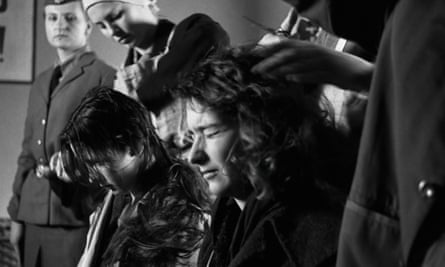A cynic might say that in making Schindler’s List, a film about an opportunistic businessman who used his factory to shelter Polish Jews from extermination in the second world war, Steven Spielberg, that undisputed master of commercial uplift, has somehow managed to find the silver lining in the darkest cloud of the 20th century. And the cynic would be right to a point: Spielberg does seek to eke out whatever humanity he can find from this scenario, even if that humanity is suppressed by arrogance and self-loathing.
But don’t miss how dark he makes the cloud. Thirty years later, it remains astonishing how Spielberg, perhaps the only film-maker Hollywood would ever agree to bankroll for a film about the Holocaust, sought to depict both grand and casual atrocities with unblinking directness, muted only slightly by Janusz Kamiński’s black-and-white photography. Here was a master of misdirection and offscreen space – a man made famous for not showing a shark for most of a killer shark movie – making the horrors of the Kraków ghetto and the Płaszów concentration camp as unvarnished as possible. We see Jews arbitrarily shot in the streets. We see bodies shuffled first into humiliating medical evaluations and later into gas chambers. We see parents screaming as their children are driven away in trucks, waving as if they’re on a field trip from which they’ll never return.
First, however, we see Liam Neeson as Oskar Schindler, dressed in a silk suit offset with a small Nazi lapel pin, nothing garish but enough to get through the door. Here Kamiński’s light turns Casablanca, with a key light across his eyes, clouded with curls of cigarette smoke. He’s far from a romantic hero, but he presents a winning image to party officials who like to be wined and dined and are open to the spoils of war profiteering. As the Nazis occupy the city and force Jews into the ghetto, Schindler gets cheap labor for his enamelware factory, with all the wages funneled to the Germans.
With Schindler supplying the “panache”, the actual business gets done by Itzhak Stern (Ben Kingsley), a Jew with deep connections in the city and the latitude to make “essential workers” out of the vulnerable. It’s not until Schindler witnesses the liquidation of the ghetto into the Płaszów camp that his conscience starts to turn. To that point, sheltering Jewish workers, even Stern, is a mere side-effect to preserving the bottom line. Doing both at once involves mollifying monsters like Amon Göth (Ralph Fiennes), an SS camp commandant and lusty war criminal given to shooting people at random from his balcony. Göth’s relationship with his Jewish maid, Helen Hirsch (Embeth Davidtz), teases out an affection he suppresses with brutality.
Working from Steven Zaillian’s script, based on Thomas Keneally’s historical fiction Schindler’s Ark, Spielberg handles Schindler’s awakening with patience, suggesting how fluidly respectable executives can tuck atrocities into business transactions. Though Schindler feels shame – nothing is worse for him than an employee thanking him for being “a good man” – the film audaciously aligns him with Göth, if only to show how they diverge from a mutually beneficial relationship. He briefly fools Göth into embracing the power of “pardoning” his lessers like a royal to a serf, but the bribes keep flowing.
Though the film honors the magnitude of 1,100 lives saved by Schindler – with thousands more branching out from those – its redemptive arc doesn’t mean it’s inattentive to the lives lost. On the contrary, Spielberg scrupulously details the Nazi killing machine as it progresses from the ghettos to construction of Płaszów to the trains leading to Auschwitz-Birkenau. He documents the banality-of-evil bureaucracy and logistics as well as the evil-of-evil plundering of Jewish property and the systematic humiliation, torture and murder that follow. Even a device that seems sentimental, like Schindler taking notice of a little girl who appears in red, ends with another life indifferently snuffed out.
Five years later, Spielberg would again cling to a heartrending angle into the second world war with Saving Private Ryan, but in both cases, the uplift is like a Trojan horse to bring the explicit horrors of events like Operation Overlord and the Holocaust to the masses with minimal varnish. Once Spielberg and Kamiński leave the glad-handing Schindler and his parties behind, the camera has an elevated newsreel quality that recalls Gillo Pontecorvo’s revolutionary classic The Battle of Algiers in its documentary authenticity. It wants to read simply as the truth, a living refutation of anyone eager to deny or minimize a genocide of unfathomable proportions.
Schindler’s List is not without its missteps. Spielberg’s peerless skill in manipulating his audience’s emotions backfires in an appalling sequence in which women are herded into a shower to get “disinfected” and wait in collective terror to get gassed, only for water to come out of the heads. Though the film later shows another group of women led to a grimmer fate, the “close call” suspense seems distasteful, as if they were Indiana Jones swinging across a snake-filled chasm. And while Schindler’s guilt over exploiting Jewish labor no doubt plagues him to the end, his speech about the additional lives he could have saved by selling his watch or his car feels like too much. Something as simply staged as the liberation of the slaves in Sansho the Bailiff would have been enough.
Yet Schindler’s List stands as a popular bulwark against conspiracists and antisemites, to say nothing of historical amnesiacs who turn atrocities into myths. Spielberg not only won best picture, along with six other Oscars, but the film was a massive box office success, capping a year that had already produced a blockbuster out of his Jurassic Park. He turned a black hole into essential viewing, a vivid reminder of the horrors human beings are capable of engineering. It’s art as a public service.

